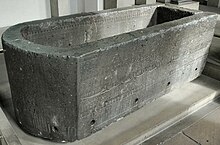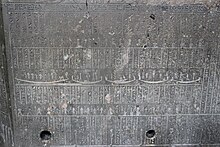User:Gadzooksopposite/Nectanebo II
*re worded some things for clarity in the first section*
Nectanebo II (Egyptian: Nḫt-Ḥr-Ḥbt; Ancient Greek: Νεκτανεβώς Nectanebos) was the last native ruler of ancient Egypt, as well as the third and last pharaoh of the Thirtieth Dynasty, reigning from 358 to 340 BC.
Under Nectanebo II, Egypt prospered. - *I feel like prospered is a stretch, due to the constant war and brevity of his reign, and not really supported by other info in the article, but let me know if you disagree*
During the reign of Nectanebo II, Egyptian artists developed a specific style that left a distinctive mark on the reliefs of the Ptolemaic Kingdom.[1] Like his indirect predecessor Nectanebo I, Nectanebo II showed enthusiasm for many of the cults of the gods within ancient Egyptian religion, and more than a hundred Egyptian sites bear evidence of his attention.[2]
*deleted mention of temple of Isis, no citation and it was Nectanbo I*
For several years, Nectanebo II was successful in keeping Egypt safe from the Achaemenid Empire.[3] However, he was betrayed by his former servant, Mentor of Rhodes, and ultimately defeated. The Persians occupied Memphis and then seized the rest of Egypt, incorporating the country into the Achaemenid Empire under Artaxerxes III. Nectanebo fled south. His subsequent fate is unknown.
*other small things*
Name- Medieval Arab authors referred to him as Naqatanibas (Arabic: ناقاطانيباس). *deleted "the" *
Rise to Power- *going to remove "Acknowledging Agesilaus, Nectanebo sent him 220 talents of gold."- no source listed and I could not find one*
*For my main contribution, I focused on a section about a sarcophagus originally crafted for Nectanebo. I'm not sure where it would best fit, under it's own section or a sub section under legacy?*
Sarcophagus
[edit]In 1798, Napoleon captured the Egyptian city of Alexandria.[4] Soon after, following The Battle of Alexandria in 1801, Napoleon's forces surrendered to the British, and conditionally turned over antiquities they had gathered from the ancient city. Notably, among these was the Rosetta Stone, as well as a seven ton sarcophagus, covered in hieroglyphics. Soon after the British secured these, they were approached by locals who believed that this was the tomb of Alexander the Great.[5] Thereafter, the sarcophagus was taken to London, where it still resides at the British Museum.[6]

For a time, the tomb was believed to have belonged to Alexander. However, after the translation of the Rosetta Stone, the writings on the sarcophagus were deciphered, and it became clear the tomb was not fashioned for him. The hieroglyphics on the tomb were sections from the Book of What is in the Underworld, and contained the cartouche of Nectanebo II.[5] The tomb was likely created for Nectanebo, before going unused as he was overthrown and fled to Nubia.[7]
It has been argued that the sarcophagus did indeed house the remains of Alexander the Great. Alexander the Great's body was temporarily entombed in Memphis following his death, and Saqqara is a suspected location of his temporary Memphite tomb. Nectanebo had erected a temple there, where he may have intended to be laid to rest. It is possible the tomb was vacant in Memphis at the same time Alexander's body was placed there. When Alexander's remains were moved to Alexandria, it may have been along with the sarcophagus.[8] *I'm explaining the argument of a scholarly article, but does it sound too much like I'm making one?*

At the Attarine Mosque, where it was found by Napoleon's men, holes had been drilled in the sarcophagus. It had been used as a ritual bath when Alexandria was under Islamic rule.[9]
*going to remove other use of the top image in the article*
I am also going to create a new section, 'archaeological evidence' with the portraits, buildings, and sarcophagus
| This is the sandbox page where you will draft your initial Wikipedia contribution.
If you're starting a new article, you can develop it here until it's ready to go live. If you're working on improvements to an existing article, copy only one section at a time of the article to this sandbox to work on, and be sure to use an edit summary linking to the article you copied from. Do not copy over the entire article. You can find additional instructions here. Remember to save your work regularly using the "Publish page" button. (It just means 'save'; it will still be in the sandbox.) You can add bold formatting to your additions to differentiate them from existing content. |
Article Draft
[edit]Lead
[edit]Article body
[edit]References
[edit]- ^ Myśliwiec, Karol (2000). The twilight of ancient Egypt: first millennium B.C.E. Cornell University Press. p. 173. ISBN 0-8014-8630-0.
- ^ Grimal, Nicolás; Nicolas-Christophe Grimal (1994). A history of ancient Egypt. Wiley-Blackwell. p. 379. ISBN 0-306-46158-7.
- ^ Sharpe, Samuel (1838). The History of Egypt under the Ptolemies. London: E. Moxon. p. 19. OCLC 4523393.
- ^ "The Campaign in Egypt". napoleon.org. Retrieved 2024-03-07.
- ^ a b Chugg, Andrew (2002). "The Sarcophagus of Alexander the Great?". Greece & Rome. 49 (1): 8–26. ISSN 0017-3835.
- ^ "sarcophagus; bath-tub (re-use); religious/ritual vessel | British Museum". www.britishmuseum.org. Retrieved 2024-03-01.
- ^ Van de Mieroop, Marc (2011). A history of ancient Egypt. Blackwell history of the ancient world (1. publ ed.). Chichester: Wiley-Blackwell. ISBN 978-1-4051-6071-1.
- ^ Chugg, Andrew (2002). "The Sarcophagus of Alexander the Great?". Greece & Rome. 49 (1): 8–26. ISSN 0017-3835.
- ^ "sarcophagus; bath-tub (re-use); religious/ritual vessel | British Museum". www.britishmuseum.org. Retrieved 2024-03-01.
